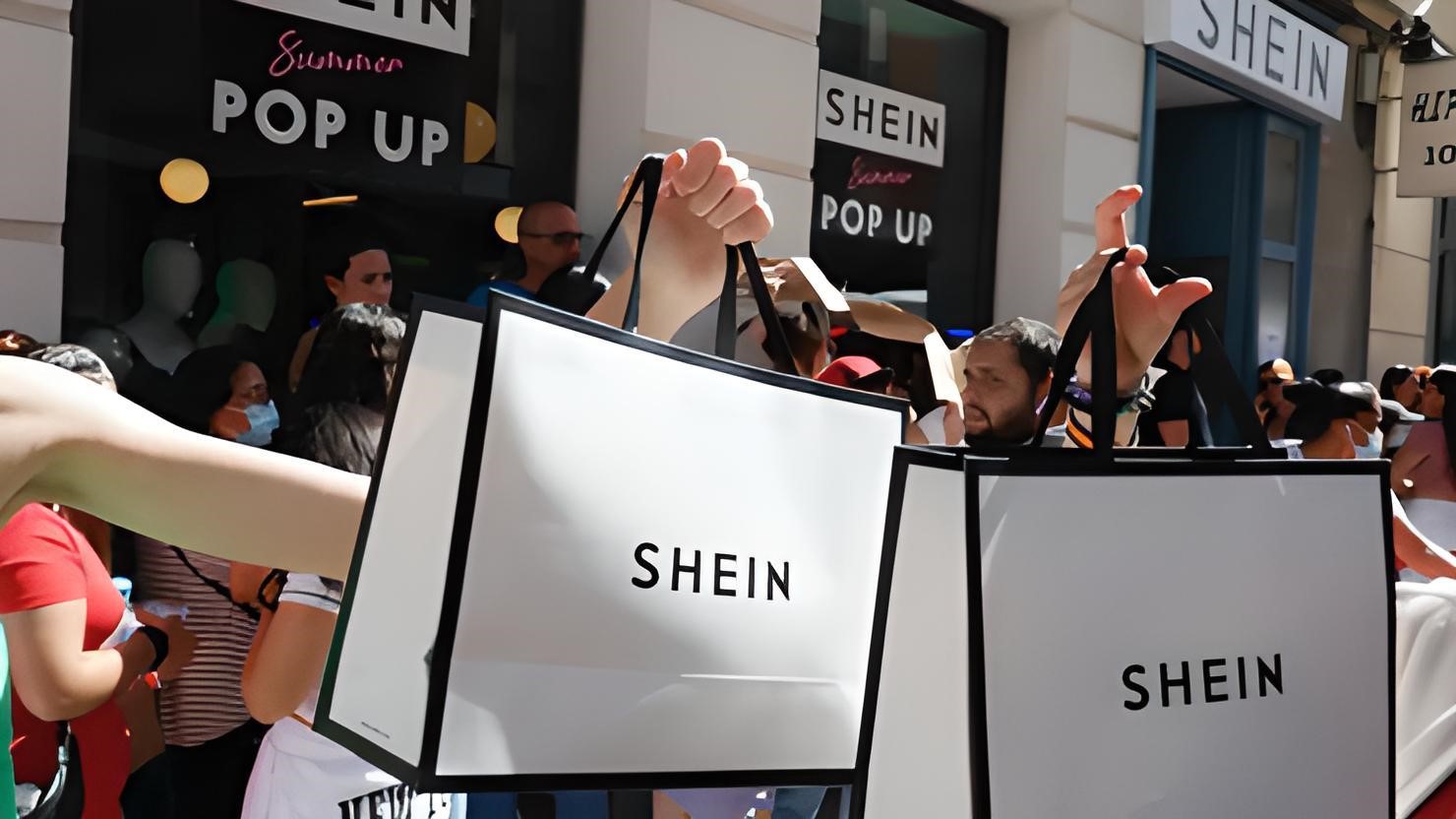
Shein. Not a household name for anyone over 30. During the pandemic, his low profile, his being shrouded in mystery, made him the most popular global ultra-fast fashion retailer[1], deified by teenagers squeezed by the economic crisis. In the space of a couple of years, Shein has risen to the pinnacle of the clothing business, making the big names that, one after the other, are in danger of disappearing, pale into insignificance. Shein is a real mystery. No telephone number, no e-mail address and no press contacts can be found online[2]. Even the year of foundation is enigmatic[3], as is the name of its founder[4].
Yet the Chinese fast fashion company has managed to gain incredible profitability and international visibility at such a speed that in just a few years it has eclipsed all global rivals such as Primark and Amazon – in online fashion distribution, it has no rivals left[5]. It is a Chinese-owned company with almost 10,000 employees and offices in China, Singapore and the United States. Most of its suppliers are located in Guangzhou, the Pearl River port city 80 miles north-west of Hong Kong[6]. Founded in 2008 and headquartered in Nanjing, it targets the ‘Z generation’[7]. i.e. young people born between 1995 and 2010[8], who like everyone else have the same needs: to belong to the wave and be unique – but have no money to spend. So they choose fast fashion[9], i.e. fashion that changes constantly, every week, and despite being industrially produced always gives the impression of being unique. Because it costs very little, is produced by exploiting employees[10], polluting without control[11] and stealing the exclusive products of the most renowned fashion brands[12].
In the mid-2000s, fast fashion is the dominant retail paradigm[13] – since China joined the World Trade Organisation and quickly became a major clothing production centre. Western companies moved a large part of their production there. It was at this time that the name of Shein’s managing director first appeared in company documents: Xu Yangtian[14]. An elusive character, he does not give interviews. It is impossible to find information about him, he does not fill the magazines, he does not go on the screen, no one really knows who he is[15].
He is among the richest men in China, but is much less well known than the likes of Jack Ma of Alibaba or Pony Ma of Tencent[16]. Also known as Chris Xu, he is described as a Chinese-American who studied at George Washington University[17], or as a Chinese born in Shandong in 1984, who studied at Qingdao University of Science and Technology. In 2008, he founded an e-commerce company, Nanjing Dianwei Information Technology[18], together with two partners, Wang Xiaohu and Li Peng. Xu and Wang each own 45% of the company and Li the remaining 10%.
Wang and Li’s version
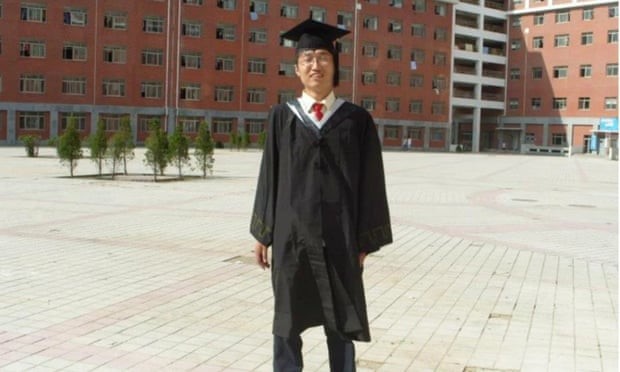
Future fashion tycoon Chris Xu at college[19]
Wang met Xu in 2008. The two decided to start an international marketing and e-commerce business. Wang takes care of business development and some financial aspects, while Xu deals with a number of more technical issues, including marketing and search engine optimisation. In the same year, Li gave a speech on online marketing at a forum in Nanjing. Xu, a slim young man with an oblong face, introduces himself and says he is looking for business advice. “He was a beginner,” says Li. But Xu immediately appears tenacious and diligent, so Li agrees to help him[20].
Xu invites Li to join him and Wang as a part-time consultant[21]. The three rent a small office in a modest building, with a large table and a handful of desks, no more than a dozen people. At first they try to sell all kinds of items, including teapots and mobile phones. Only later do they start selling clothes as well[22]. The three have a brilliant idea. If foreign companies use Chinese suppliers to produce clothes for customers abroad, surely a company run by Chinese could do the same more successfully.
They buy individual samples of clothing at the Guangzhou market. They then list these products online and post English-language advertisements on blogging platforms such as WordPress and Tumblr. Only when an item starts selling do they place a small wholesale order with a particular wholesaler[23]. As sales increase, Li starts to study online trends to predict which new styles might become popular and place orders in advance. They use a site called Lookbook.nu to find young Western influencers, who send them clothing for free[24].
All this time, Xu works long hours, often staying at the office even after the others have gone home. Xu does not speak much, but tells Li that he grew up in poverty in Shandong province. The company grew to about 20 employees, all of whom were paid fairly well[25]. But one day, after more than a year in business, Wang shows up at the office and discovers that Xu has disappeared. Some company passwords have been changed. Wang, calls and texts Xu without getting an answer, then looks for him everywhere. Xu has disappeared. Worse still, Xu has control of the PayPal accounts that the company uses to receive international payments[26]. Wang informs Li, then pays the company’s remaining expenses and dismisses the employees. He later learns that Xu has continued to operate the e-commerce business without them.
The ascent to success
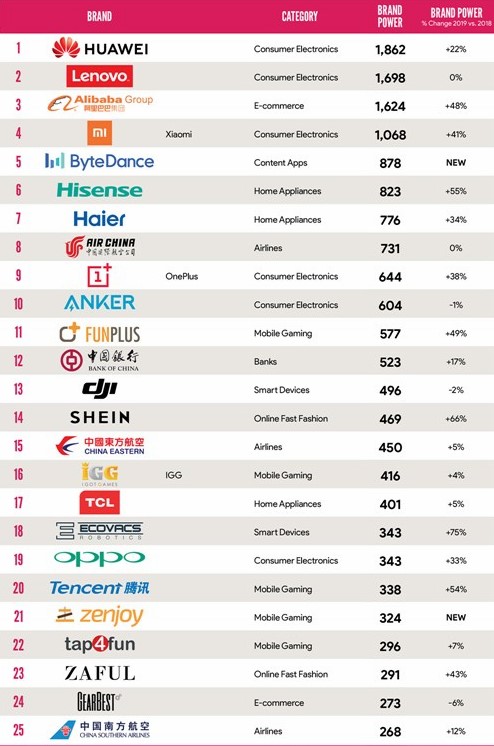
2019: Shein’s surprising placement among Chinese brands[27]
In March 2011, Xu registered the website Shein-SheInside.com[28], which he started by selling wedding dresses[29]. In September 2012, he registered a company with a slightly different name from the one he founded with Wang and Li, Nanjing Dianshang Information Technology, in which he holds a 70% share[30]. In 2013, Jafco Asia financed Xu’s company with USD 5 million[31]. In 2015, the company gets another $47 million investment.
Xu changes its name to Shein and moves its headquarters from Nanjing to Guangzhou, to be close to suppliers[32]. It focuses on fast fashion by targeting foreign markets and begins to acquire rivals in the fashion field[33]. He quietly opens a US office in an industrial area of Los Angeles County and buys the Romwe site[34], a brand that, coincidentally, Li had created with a girlfriend years earlier, and which he left before Xu took it over. In 2019, according to Coresight Research estimates[35], Shein achieves sales of USD 4 billion[36].
In the same year, advertising holding company WPP, in collaboration with Google, publishes the ‘2019 BrandZ Top 50 Chinese Global Brand Builders’ report, which shows consumers’ predisposition to choose a particular brand. Each brand is present in seven foreign markets, France, Germany, Spain, the UK, the US, Australia and Japan. Shein is among the first brands to be chosen[37], despite the fact that very few people in China have heard of it[38]. As the pandemic destroys the garment industry in 2020, Shein’s sales continue to grow, reaching USD 10 billion in 2020 and USD 15.7 billion in 2021[39].
In July 2021, Shein’s app became the most downloaded app, with over 17.5 million downloads, in the Google Play and Apple stores. It is the most mentioned brand on TikTok[40] , far surpassing Netflix (which comes second), three times more than McDonald’s and Starbucks[41]. In April 2022, Shein received private funding (it is not known from whom) worth between USD 1 and 2 billion[42]. The brand is now valued at USD 100 billion (EUR 91 billion)[43], which is as much as Zara and H&M combined[44]. The next goal is to become a listed company in the United States in 2024[45]. Its growth in recent years has been supported by venture capital companies, led by Tiger Global Management, Sequoia Capital China and General Atlantic[46].
The latest move is from last February. Reuters states that Xu has moved to Singapore, leaving Molly Miao as Shein’s legal representative in China. An important step to obtain citizenship: Singapore is home to Roadget Business, the legal operators of Shein’s website. Useful for circumventing China’s strict and often unpredictable regulation of offshore IPOs[47].
How does Shein work?
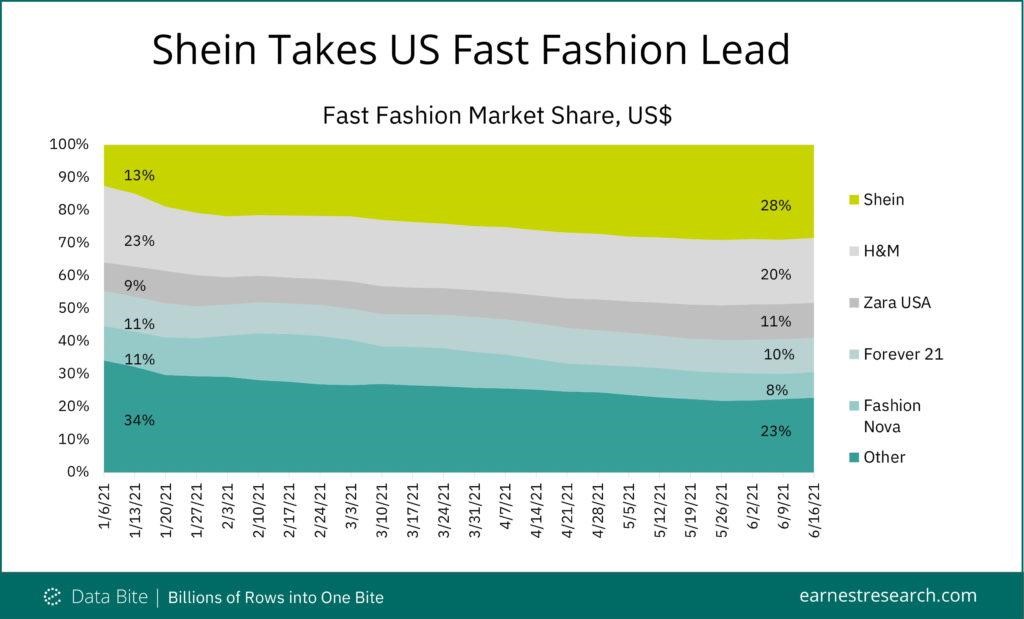
Shein now leads the world’s fast fashion[48]
The company relies mainly on digital marketing and bloggers to convince teenagers to buy its products[49]: a non-transparent way to entice them to buy, and it probably works precisely because of this aura of secrecy. The Chinese brand does not have its own identity or aesthetics, but uses algorithms and data analysis to intercept the fashions of various countries and re-propose them as quickly as possible in its collections, often explicitly copying the creations of fashion designers, with a much lower quality. The life cycle of an article is very short, garments are made to be worn only a few times, a sort of programmed obsolescence, and then get bored in favour of the new collection[50].
The software used quickly identifies which garments are the most popular and automatically reorders them; for models with disappointing sales, production is stopped[51]. The designer is useless; in his place are engineers and sophisticated software that enable the production of clothes designed to be used a handful of times and destined for the dump[52]. Shein initially places a small order (between 50 and 100 pieces). If they like the product, it is then mass-produced on a larger scale[53]. The finished clothes are sent to huge distribution centres. Here they are sorted into customer parcels. Then they are shipped directly to people’s homes in the US and over 150 other countries – in contrast to the competition, which ships huge quantities of clothes around the world in containers, and then finds tons of unsold fabric[54].
It is not the only company that places small initial orders with suppliers, and then reorders when the products are successful. Boohoo, the British fast-fashion brand[55] put into crisis by Shein itself, contributed to the spread of this industrial model by copying it. But the Chinese company has an advantage over its Western competitors: while many international brands, including Boohoo itself, use suppliers in China, Shein’s geographical and cultural proximity allows it to be faster.
Shein’s model, based exclusively on online, allows it to avoid, unlike its major fast fashion competitors, the management and staffing costs of physical shops, including managing shelves full of unsold clothes at the end of each season[56]. According to the BBC, only 6% of Shein’s inventory remains in stock for more than 90 days. Every day Shein updates its website with an average of 6,000 new designs[57], an outrageous figure even in the context of fast fashion.
Lu, a professor at the University of Delaware, found that in a 12-month period, Gap listed about 12,000 different items on its website, H&M about 25,000 and Zara about 35,000. Shein, in the same period, had 1.3 million[58]. To increase sales and visibility, the brand aggressively pushes its ads on Tik-Tok and Instagram ‘haul’ videos[59], signing contracts with influencers such as Addison Rae[60], the world’s third most followed person on social[61], Makenna Kelly[62] and reality stars such as Georgia Toffolo of ‘Made in Chelsea’[63].

In this Instagram post, Addison Rae and Shein collaborate to promote Shein’s new summer collection, offering discount codes to their audience[64]
Influencer marketing is one of the main ways in which companies get in touch with potential consumers. The benefits are for both parties. The company can associate itself with the influencer and borrow the trust the latter has earned from its audience[65]. In turn, the influencers share the discount codes with their followers and earn a commission on sales. According to HypeAuditor[66], this strategy has made Shein the most talked-about brand on Instagram, YouTube and TikTok[67]: young buyers are attracted to buy the designs because of the low price charged (a dress costs just half of a Zara equivalent)[68].
In China, many claim that the company is becoming ‘the Chinese version of Zara’, but its aim is even to annihilate it[69]. To promote its products, the company often hosts live shows on its platforms. This is more unique than rare as live streaming is less used by Western brands, but has enormous potential to boost sales, as demonstrated in China[70]. The US is the largest market: Shein represents almost a third (28%) of the fast fashion market here[71].
The company ships to 220 countries, including Europe, the Middle East, Australia and the US[72]. It has virtually no retail presence in China, which is not holding back its growth[73]. To lead its expansion in Europe[74], last summer it hired Jacobo Garcia Miña, whose CV includes senior roles at Inditex and the British luxury label Burberry. While Shein opens pop-up shops[75] in major European cities, Garcia Miña oversees operations from Dublin.
Shein owes its success to the war on tariffs, cleverly exploiting the international trade system. In 2018, with trade relations between the two powers in crisis, China responded to a new round of US duties by waiving export taxes[76]. Shipping small packages from China to the US costs less than shipping them from other countries or even from the US itself[77]. The company ships most of its orders from China, and since parcels worth less than USD 800 are exempt from customs fees in the US, the company was hardly affected even when Trump imposed high tariffs to make Chinese products more expensive[78]. In addition to the Los Angeles location, the company also recently opened a distribution centre in the Indianapolis area and an office near Washington[79].
To serve the US market, the products are shipped from Shein’s warehouse in Foshan, Guangdong province, and delivery can take more than ten days, a huge amount of time compared to Amazon Prime. But the super-cheap prices ensure a loyal customer base, attracted by an ever-changing assortment of women’s clothing and accessories[80]. A designer working for the company calculates that from design to production, and from there to sale, it takes only three days[81]. Its production cycle is faster than that of Inditex, owner of Zara, Pull&Bear, Massimo Dutti, Bershka, Stradivarius, Oysho, Zara Home and Uterqüe[82].
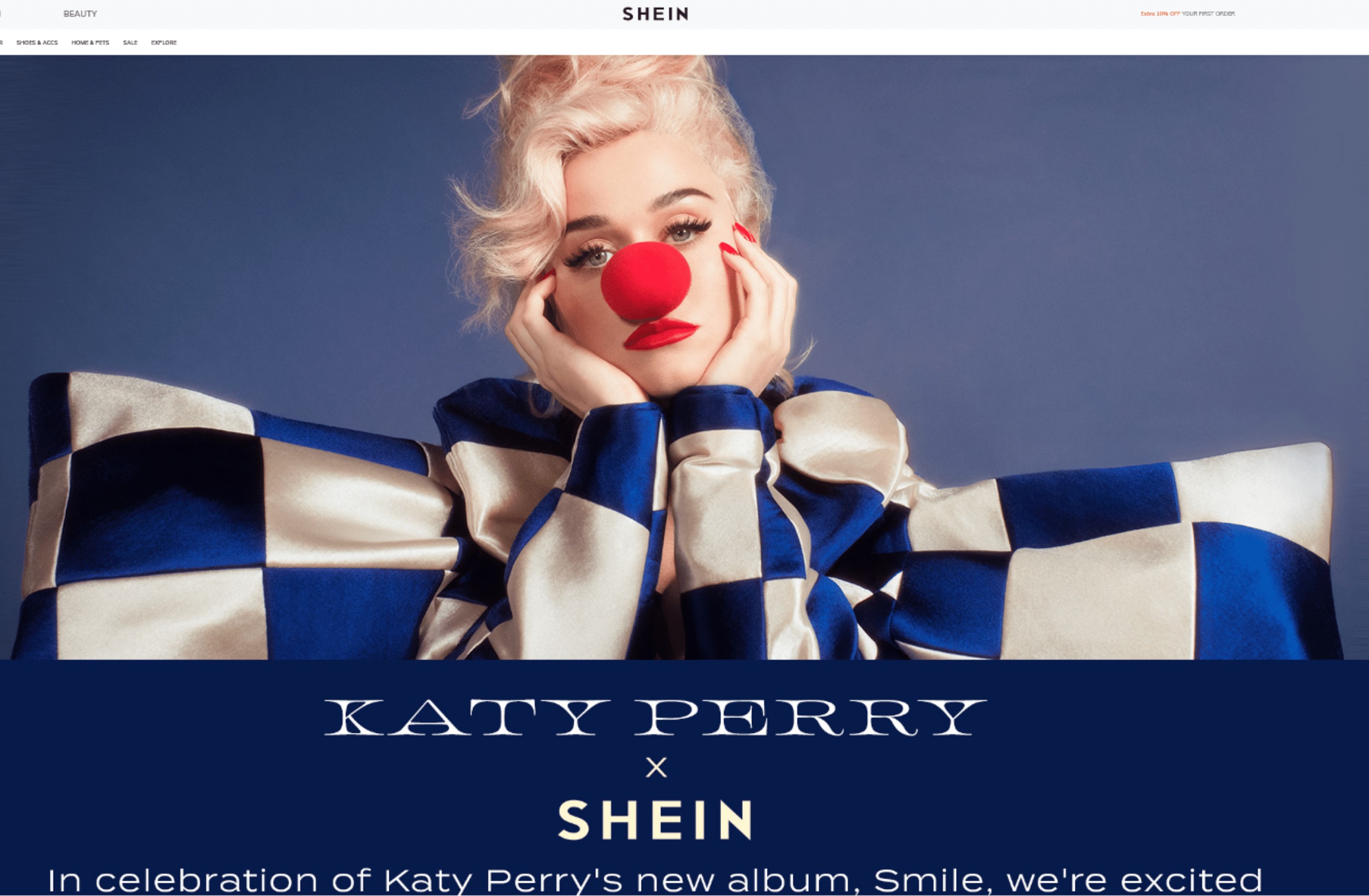
Joint publicity for Shein and Katy Perry’s new album[83]
This means (for example) that after the new styles are displayed during Global Fashion Week, you only have to wait a week and you can see the finished, slightly modified products in Shein’s online shop[84]. The Chinese company even managed to land stars such as Katy Perry, Lil Nas X and Rita Ora[85] for its May 2020 global streaming event #SHEINTogether [86]: all this for a company that before 2014 did not even have its own supply chain, buying directly from Guangzhou’s wholesale market Shisanhang Garment[87]. Also in 2014, Shein entered the Middle East and sales soared, with turnover rising to USD 617 million in 2016 and exceeding USD 1.5 billion the following year[88].
The hundreds of factories that work with the company have come together in a production centre very similar to the one in La Coruña, in north-eastern Spain, where Inditex’s headquarters are located[89]. Shein has four research and development facilities in Nanjing, Shenzhen, Guangzhou and Hangzhou, as well as six logistics centres in Foshan, Nansha, Belgium, India and on the east and west coasts of the United States[90]. Future plans include the development of new businesses in the areas of mobile payments, supply chain, advertising and, of course, shop openings. Whatever happens, it is likely to be ultra-fast[91].
Why is Shein dangerous?
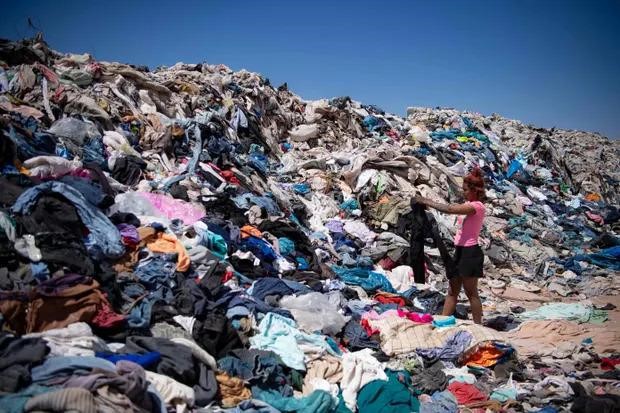
Most returned textiles end up in landfills[92]
Stifled by inflation and the impoverishment of the working classes, to the detriment of sustainability and eco-friendliness, fast fashion is the must-have trend for the new generations[93]. In order to have fashionable clothes, often ugly copies of famous brands, young people, spending derisory sums, constantly vary their wardrobes, producing enormous quantities of waste. The volume of textiles in US landfills has almost doubled in the last two decades[94]. Production requires large quantities of chemicals, water and energy: according to the World Resources Institute, the industrial production of one line of cotton T-shirts requires 2700 litres of water, the equivalent of the average consumption a person drinks in two and a half years[95].
To keep prices low, fast fashion companies often use polyester fabrics, derived from oil and coal mining, which are not biodegradable like natural materials[96]. The fashion industry is the second largest polluter in the world, and brands like Shein are a key part of that pollution. The process to generate polyester in one year produces the same amount of CO2 as 180 coal-fired power plants[97], or about 700 million tonnes of CO2 per year[98]. Estimates say it could double by 2030[99].
Europe tries to protect itself. Last March, the European Commission presented a proposal to tackle the environmental damage caused by fast fashion. The proposal includes setting standards for the durability and reusability of clothes and requiring companies to include sustainability information on labels[100]. A 2021 investigation of Shein[101] by the Canadian Broadcasting Corporation found high levels of lead, phthalates and polyfluoroalkyl substances (PFAS): chemicals that create health problems in children’s and adult clothing, especially for pregnant women[102].
And when natural materials are used, Shein is no better. Laboratory tests have found that garments shipped to the US are made from cotton from Xinjiang[103]. The region is notorious for the widespread use of forced labour by the oppressed Uyghur population[104], a Turkic-speaking ethnic group of predominantly Muslim faith[105], which produces over 80% of China’s cotton. President Biden signed a law banning the import of products manufactured in Xinjiang. But Shein’s parcels are generally sent by post, rather than by container. They are unlikely to be examined by US customs[106].
The business model is set up to feed demand, ensuring that there is always something new[107]. In a world where the average consumer throws away 60 per cent of new clothes in the same year they are purchased[108], Shein is a relevant part of this system[109]. Yet, after numerous denunciations by Greenpeace and other NGOs, Shein is using the sustainability card to attract young consumers[110] by launching a service on its app that allows them to buy and sell used Shein fashion.
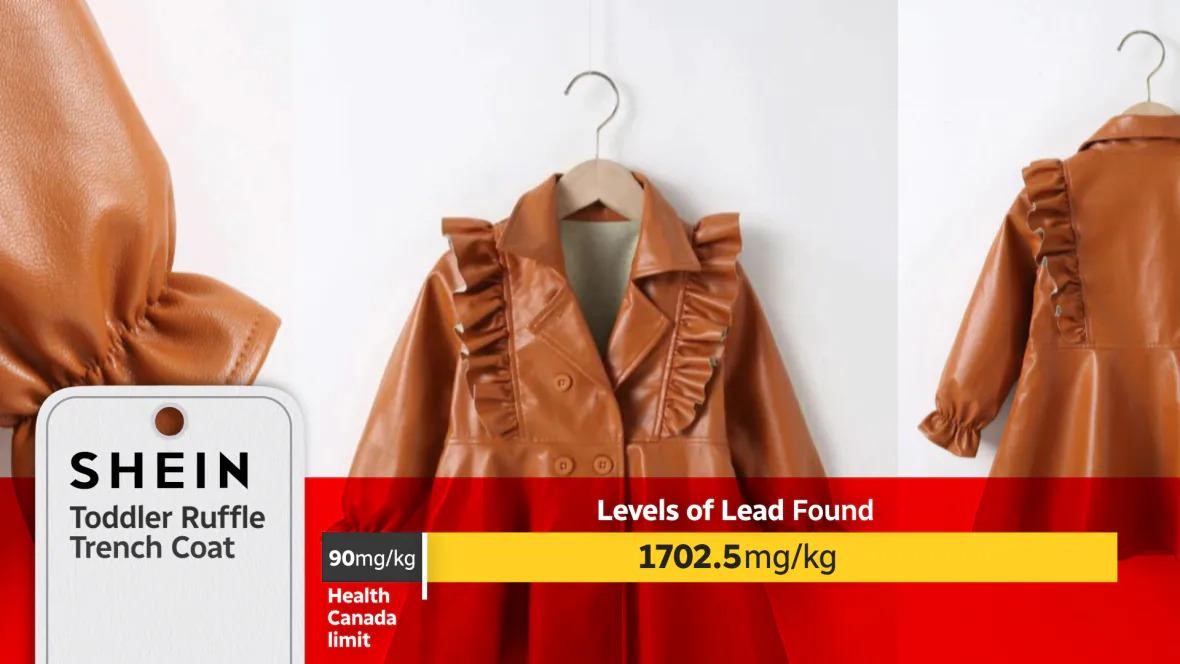
This children’s jacket ($23 on Shein) exceeds the permissible lead limit by more than 20 times according to Health Canada[111]
It is an explicit nod to young people’s desire for more sustainable fashion. But it is also something more pragmatic: an effort to grab a slice of a clothing, footwear and accessories resale market that has tripled in value to $120 billion since 2020[112]. Meanwhile, the workers who sew the clothes are paid very little to work in gruelling and sometimes dangerous conditions[113]: only 4 cents per garment, and they produce at least 500 per day[114], in 18-hour shifts[115], with breaks of about 90 minutes for lunch and dinner. They work seven days a week, with one day off a month: a schedule forbidden by Chinese law[116].
The monthly salary is about 4000 yuan (about 550 Euro) and is withheld the first month. For every mistake made, the seamstresses are deducted two thirds of their daily pay[117]. The exploitation of workers does not only take place in Asian countries, it is a global problem, and only consumers of all generations, with their own choices, can reverse this trend[118], but those who buy Shein do not know these things or do not find them relevant.
Shein does not respect any rules: in its haste to launch new articles it often commits design theft and gross errors. Some time ago she was condemned for putting on sale a pendant in the shape of a swastika (a mistake for which she apologised)[119], then a Muslim prayer mat sold as a ‘Greek rug’, which was only removed after customer complaints[120]. Designers search for patterns on the Internet, copy other people’s work and then sell it to Shein[121], which only asks its designers to modify the patterns so that they are ‘no longer recognisable’[122].
But this does not prevent legal disputes: Leah Flores, a photographer and artist from Portland, discovered that Shein had copied a photo of her and is selling it on a tapestry for USD 10. Looking deeper into the website, she found seven other works that she owned. Flores sued Shein, obtaining compensation of $40,000. A couple of days after receiving the first cheque, he found four more stolen images on Shein and Romwe[123]. Bailey Prado, a crochet designer based in Los Angeles and London, accused Shein of stealing 45 of her designs[124]. In many other cases, however, small designers seem to be simply exploited. A musician named Katie Bailey found a T-shirt she had commissioned from an illustrator to promote her band on the site. Shein initially removed the article, then it reappeared a month later, with slight modifications, on Romwe.

One of the models stolen from designer Bailey Prado[125]
One thing is certain: if Shein were to change style, another start-up could come along and take its place. Other companies in China are following a similar business model. Last year, Alibaba, the Chinese e-commerce giant, launched a low-cost clothing site for the European market called AllyLikes[126]. The prediction, however, is that Shein will become even bigger, going beyond fashion and becoming like Amazon, given the wide range of new products on offer, such as pet articles and household items[127].
Fast fashion is designed to suit busy lives. Low prices invite low maintenance (it’s cheaper and quicker to throw away than to wash and iron), low risk, or so it seems (you buy fast, no need to regret if it doesn’t fit), and convenience is unparalleled (swipe, click and answer the door)[128]. In the absence of clear rules for the fast-growing global e-commerce companies, the burden of making fashion more ethical will continue to fall largely on individual consumers: a strategy destined to fail[129].
Cheap clothing, produced by exploiting human beings, is reminiscent of slavery situations that belong to the past. This is why opinion on Shein is sharply divided: there are those who call it inclusive, thanks to its prices, and those who criticise it for its environmental impact, slave-like treatment and theft of creative works. We should have no illusions: ultra-fast fashion has little to do with democratisation and much more to do with profit.
Governments allow this business model: they do not take into account the costs in terms of pollution, land degradation, damage to biodiversity and sociality. So the responsibility, once again, falls on our awareness as citizens: the right attitude towards our purchasing decisions is the only real tool we have to fight the Chinese ogre that, in the shadows and with our money, continues to grow.
[1] https://www.forbes.com/sites/markfaithfull/2021/02/10/shein-is-chinas-mysterious-15-billion-fast-fashion-retailer-ready-for-stores/?sh=b1b892b6df5a
[2] https://www.euronews.com/green/2022/04/05/welcome-to-the-dark-side-shein-is-the-biggest-rip-off-since-fast-fashion-was-born
[3] https://www.wired.com/story/fast-cheap-out-of-control-inside-rise-of-shein/
[4] https://www.euronews.com/green/2022/04/05/welcome-to-the-dark-side-shein-is-the-biggest-rip-off-since-fast-fashion-was-born
[5] https://jingdaily.com/shein-ipo-working-conditions-sustainability/
[6] https://www.wired.com/story/fast-cheap-out-of-control-inside-rise-of-shein/
[7] https://www.forbes.com/sites/markfaithfull/2021/02/10/shein-is-chinas-mysterious-15-billion-fast-fashion-retailer-ready-for-stores/?sh=b1b892b6df5a
[8] https://www.tpi.it/esteri/shein-moda-ultra-veloce-danni-permanenti-ambiente-lavoratori-consumatori-20230113969538/
[9] https://thevou.com/fashion/fast-fashion/
[10] https://globallaborjustice.org/gap/
[11] https://aaltodoc.aalto.fi/handle/123456789/112926
[12] https://www.theatlantic.com/magazine/archive/2021/03/ultra-fast-fashion-is-eating-the-world/617794/
[13] https://thevou.com/fashion/fast-fashion/
[14] https://www.wired.com/story/fast-cheap-out-of-control-inside-rise-of-shein/
[15] https://www.theguardian.com/business/2022/jul/30/chris-xu-shein-mysterious-billionaire-founder-fast-fashion
[16] https://www.theguardian.com/business/2022/jul/30/chris-xu-shein-mysterious-billionaire-founder-fast-fashion
[17] https://www.forbes.com/sites/markfaithfull/2021/02/10/shein-is-chinas-mysterious-15-billion-fast-fashion-retailer-ready-for-stores/?sh=b1b892b6df5a
[18] https://www.theguardian.com/business/2022/jul/30/chris-xu-shein-mysterious-billionaire-founder-fast-fashion
[19] https://www.theguardian.com/business/2022/jul/30/chris-xu-shein-mysterious-billionaire-founder-fast-fashion
[20] https://www.wired.com/story/fast-cheap-out-of-control-inside-rise-of-shein/
[21] https://www.wired.com/story/fast-cheap-out-of-control-inside-rise-of-shein/
[22] https://www.theguardian.com/business/2022/jul/30/chris-xu-shein-mysterious-billionaire-founder-fast-fashion
[23] https://www.wired.com/story/fast-cheap-out-of-control-inside-rise-of-shein/
[25] https://www.wired.com/story/fast-cheap-out-of-control-inside-rise-of-shein/
[26] https://www.theguardian.com/business/2022/jul/30/chris-xu-shein-mysterious-billionaire-founder-fast-fashion
[27] https://news.cgtn.com/news/3d3d674e30497a4e33457a6333566d54/index.html
[28] https://www.wired.com/story/fast-cheap-out-of-control-inside-rise-of-shein/
[29] https://www.forbes.com/sites/markfaithfull/2021/02/10/shein-is-chinas-mysterious-15-billion-fast-fashion-retailer-ready-for-stores/?sh=b1b892b6df5a
[30] https://www.wired.com/story/fast-cheap-out-of-control-inside-rise-of-shein/
[32] https://www.wired.com/story/fast-cheap-out-of-control-inside-rise-of-shein/
[33] https://www.forbes.com/sites/markfaithfull/2021/02/10/shein-is-chinas-mysterious-15-billion-fast-fashion-retailer-ready-for-stores/?sh=b1b892b6df5a
[34] https://it.shein.com/Brands/ROMWE-sc-01455667.html
[35] https://coresight.com/research/shein-how-is-the-chinese-brand-conquering-the-us-fast-fashion-market/#title1
[36] https://www.wired.com/story/fast-cheap-out-of-control-inside-rise-of-shein/
[37] https://news.cgtn.com/news/3d3d674e30497a4e33457a6333566d54/index.html
[38] https://daydaynews.cc/en/technology/731502.html
[39] https://www.wired.com/story/fast-cheap-out-of-control-inside-rise-of-shein/
[40] https://www.statista.com/statistics/1256499/brands-tiktok-mentions/
[41] https://www.euronews.com/green/2022/10/17/how-are-shein-hauls-making-our-planet-unlivable
[42] https://www.wired.com/story/fast-cheap-out-of-control-inside-rise-of-shein/
[43] https://www.euronews.com/green/2022/04/05/welcome-to-the-dark-side-shein-is-the-biggest-rip-off-since-fast-fashion-was-born
[44] https://forbes.it/2022/10/21/shein-sfruttamento-lavoro-channel-4-fast-fashion/
[45] https://technode.com/2022/07/15/fast-fashion-retailer-shein-eyes-new-york-ipo-in-2024/
[46] https://forbes.it/2022/10/21/shein-sfruttamento-lavoro-channel-4-fast-fashion/
[47] https://www.theguardian.com/business/2022/jul/30/chris-xu-shein-mysterious-billionaire-founder-fast-fashion
[48] https://www.earnestanalytics.com/shein-leads-fast-fashion/
[49] https://www.euronews.com/green/2022/04/05/welcome-to-the-dark-side-shein-is-the-biggest-rip-off-since-fast-fashion-was-born
[50] https://www.tpi.it/esteri/shein-moda-ultra-veloce-danni-permanenti-ambiente-lavoratori-consumatori-20230113969538/
[51] https://jingdaily.com/shein-ipo-working-conditions-sustainability/
[52] https://www.theguardian.com/fashion/2022/apr/10/shein-the-unacceptable-face-of-throwaway-fast-fashion
[53] https://www.euronews.com/green/2022/10/17/how-are-shein-hauls-making-our-planet-unlivable
[54] https://www.wired.com/story/fast-cheap-out-of-control-inside-rise-of-shein/
[55] https://www.solomodasostenibile.it/2020/07/10/schiavitu-fast-fashion/#:~:text=E’%20stata%20una%20vera%20e,che%20produce%20per%20il%20marchio.
[56] https://www.wired.com/story/fast-cheap-out-of-control-inside-rise-of-shein/
[57] https://www.bbc.com/news/business-59163278
[58] https://www.wired.com/story/fast-cheap-out-of-control-inside-rise-of-shein/
[59] https://www.tpi.it/esteri/shein-moda-ultra-veloce-danni-permanenti-ambiente-lavoratori-consumatori-20230113969538/
[60] https://www.weekinchina.com/2021/05/fast-and-sassy/
[61] https://www.vanityfair.it/article/addison-rae-bannata-da-tiktok
[62] https://www.news.com.au/finance/money/wealth/how-us-teen-makenna-kelly-amassed-11-million-youtube-subscribers/news-story/01f3f3cf368f96a161a64376ed0bf2b0
[63] https://www.bbc.com/news/business-59163278
[64] https://medium.com/@dboccarossa/addison-rae-and-shein-team-up-on-instagram-933c7820f96a
[65] https://medium.com/@dboccarossa/addison-rae-and-shein-team-up-on-instagram-933c7820f96a
[67] https://www.wired.com/story/fast-cheap-out-of-control-inside-rise-of-shein/
[68] https://www.forbes.com/sites/markfaithfull/2021/02/10/shein-is-chinas-mysterious-15-billion-fast-fashion-retailer-ready-for-stores/?sh=b1b892b6df5a
[69] https://daydaynews.cc/en/technology/731502.html
[70] https://www.bbc.com/news/business-59163278
[71] https://www.earnestanalytics.com/shein-leads-fast-fashion/
[72] https://www.bbc.com/news/business-59163278
[73] https://www.weekinchina.com/2021/05/fast-and-sassy/
[74] https://ww.fashionnetwork.com/news/Shein-hires-development-director-for-european-market,1426375.html
[75] https://www.theguardian.com/business/2022/jul/30/chris-xu-shein-mysterious-billionaire-founder-fast-fashion
[76] https://forbes.it/2022/10/21/shein-sfruttamento-lavoro-channel-4-fast-fashion/
[77] https://www.wired.com/story/fast-cheap-out-of-control-inside-rise-of-shein/
[78] https://forbes.it/2022/10/21/shein-sfruttamento-lavoro-channel-4-fast-fashion/
[79] https://www.wired.com/story/fast-cheap-out-of-control-inside-rise-of-shein/
[80] https://www.forbes.com/sites/markfaithfull/2021/02/10/shein-is-chinas-mysterious-15-billion-fast-fashion-retailer-ready-for-stores/?sh=b1b892b6df5a
[81] https://www.forbes.com/sites/markfaithfull/2021/02/10/shein-is-chinas-mysterious-15-billion-fast-fashion-retailer-ready-for-stores/?sh=b1b892b6df5a
[82] https://www.inditexcareers.com/portalweb/it/inditex
[83] https://prosperousamerica.org/katy-perry-shills-for-shein-as-chinas-direct-to-us-consumer-model-takes-hold/
[84] https://daydaynews.cc/en/technology/731502.html
[85] https://www.forbes.com/sites/markfaithfull/2021/02/10/shein-is-chinas-mysterious-15-billion-fast-fashion-retailer-ready-for-stores/?sh=b1b892b6df5a
[86] https://us.shein.com/campaign/sheintogether
[87] https://www.alamby.com/guidance/guangzhou/shisan-hang/
[88] https://www.alamby.com/guidance/guangzhou/shisan-hang/
[89] https://www.forbes.com/sites/markfaithfull/2021/02/10/shein-is-chinas-mysterious-15-billion-fast-fashion-retailer-ready-for-stores/?sh=b1b892b6df5a
[90] https://www.weekinchina.com/2021/05/fast-and-sassy/
[91] https://www.forbes.com/sites/markfaithfull/2021/02/10/shein-is-chinas-mysterious-15-billion-fast-fashion-retailer-ready-for-stores/?sh=b1b892b6df5a
[92] https://www.theguardian.com/fashion/2022/apr/10/shein-the-unacceptable-face-of-throwaway-fast-fashion
[93] https://www.bloomberg.com/opinion/articles/2022-04-10/shein-s-100-billion-valuation-is-fast-fashion-s-big-moment
[94] https://www.theguardian.com/fashion/2022/apr/10/shein-the-unacceptable-face-of-throwaway-fast-fashion
[95] https://www.tpi.it/esteri/shein-moda-ultra-veloce-danni-permanenti-ambiente-lavoratori-consumatori-20230113969538/
[96] https://www.bbc.com/news/business-59163278
[97] https://www.euronews.com/green/2022/10/17/how-are-shein-hauls-making-our-planet-unlivable
[98] https://changingmarkets.org/portfolio/fossil-fashion/
[99] https://www.euronews.com/green/2022/10/17/how-are-shein-hauls-making-our-planet-unlivable
[100] https://www.wired.com/story/fast-cheap-out-of-control-inside-rise-of-shein/
[101] https://www.cbc.ca/news/business/marketplace-fast-fashion-chemicals-1.6193385
[102] https://www.insider.com/toxic-chemicals-in-shein-and-other-fast-fashion-clothing-2022-8
[103] https://www.bloomberg.com/news/features/2022-11-21/shein-s-cotton-clothes-tied-to-xinjiang-china-region-accused-of-forced-labor
[104] https://www.bloomberg.com/news/audio/2022-11-21/shein-s-fast-fashion-comes-at-a-steep-cost-podcast
[105] https://www.osservatoriodiritti.it/2019/04/24/uiguri-cina-chi-sono-storia-persecuzione-xinjiang/
[106] https://www.wired.com/story/fast-cheap-out-of-control-inside-rise-of-shein/
[107] https://www.euronews.com/green/2022/10/17/how-are-shein-hauls-making-our-planet-unlivable
[108] https://neomam.com/blog/fast-fashion-drowning-in-clothes
[109] https://www.euronews.com/green/2022/10/17/how-are-shein-hauls-making-our-planet-unlivable
[110] https://forbes.it/2022/10/21/shein-sfruttamento-lavoro-channel-4-fast-fashion/
[111] https://www.cbc.ca/news/business/marketplace-fast-fashion-chemicals-1.6193385
[112] https://www.bloomberg.com/opinion/articles/2022-11-03/shein-exchange-fast-fashion-resale-won-t-solve-its-waste-problem
[113] https://www.wired.com/story/fast-cheap-out-of-control-inside-rise-of-shein/
[114] https://forbes.it/2022/10/21/shein-sfruttamento-lavoro-channel-4-fast-fashion/
[115] https://www.euronews.com/green/2022/10/17/how-are-shein-hauls-making-our-planet-unlivable
[116] https://www.wired.com/story/fast-cheap-out-of-control-inside-rise-of-shein/
[117] https://forbes.it/2022/10/21/shein-sfruttamento-lavoro-channel-4-fast-fashion/
[118] https://www.solomodasostenibile.it/2020/07/10/schiavitu-fast-fashion/#:~:text=E’%20stata%20una%20vera%20e,che%20produce%20per%20il%20marchio.
[119] https://www.forbes.com/sites/markfaithfull/2021/02/10/shein-is-chinas-mysterious-15-billion-fast-fashion-retailer-ready-for-stores/?sh=b1b892b6df5a
[120] https://www.bbc.com/news/business-59163278
[121] https://www.theguardian.com/business/2022/jul/30/chris-xu-shein-mysterious-billionaire-founder-fast-fashion
[122] https://www.wired.com/story/fast-cheap-out-of-control-inside-rise-of-shein/
[123] https://www.wired.com/story/fast-cheap-out-of-control-inside-rise-of-shein/
[124] https://www.euronews.com/green/2022/10/17/how-are-shein-hauls-making-our-planet-unlivable
[125] https://www.instagram.com/p/CSSJOIcpM_T/?utm_source=ig_embed&ig_rid=f7ae92b7-d5cc-4848-b68e-a4a1d7533b54
[126] https://www.allylikes.com/?lang=it
[127] https://www.wired.com/story/fast-cheap-out-of-control-inside-rise-of-shein/
[128] https://www.theguardian.com/fashion/2022/apr/10/shein-the-unacceptable-face-of-throwaway-fast-fashion
[129] https://www.wired.com/story/fast-cheap-out-of-control-inside-rise-of-shein/
Leave a Reply